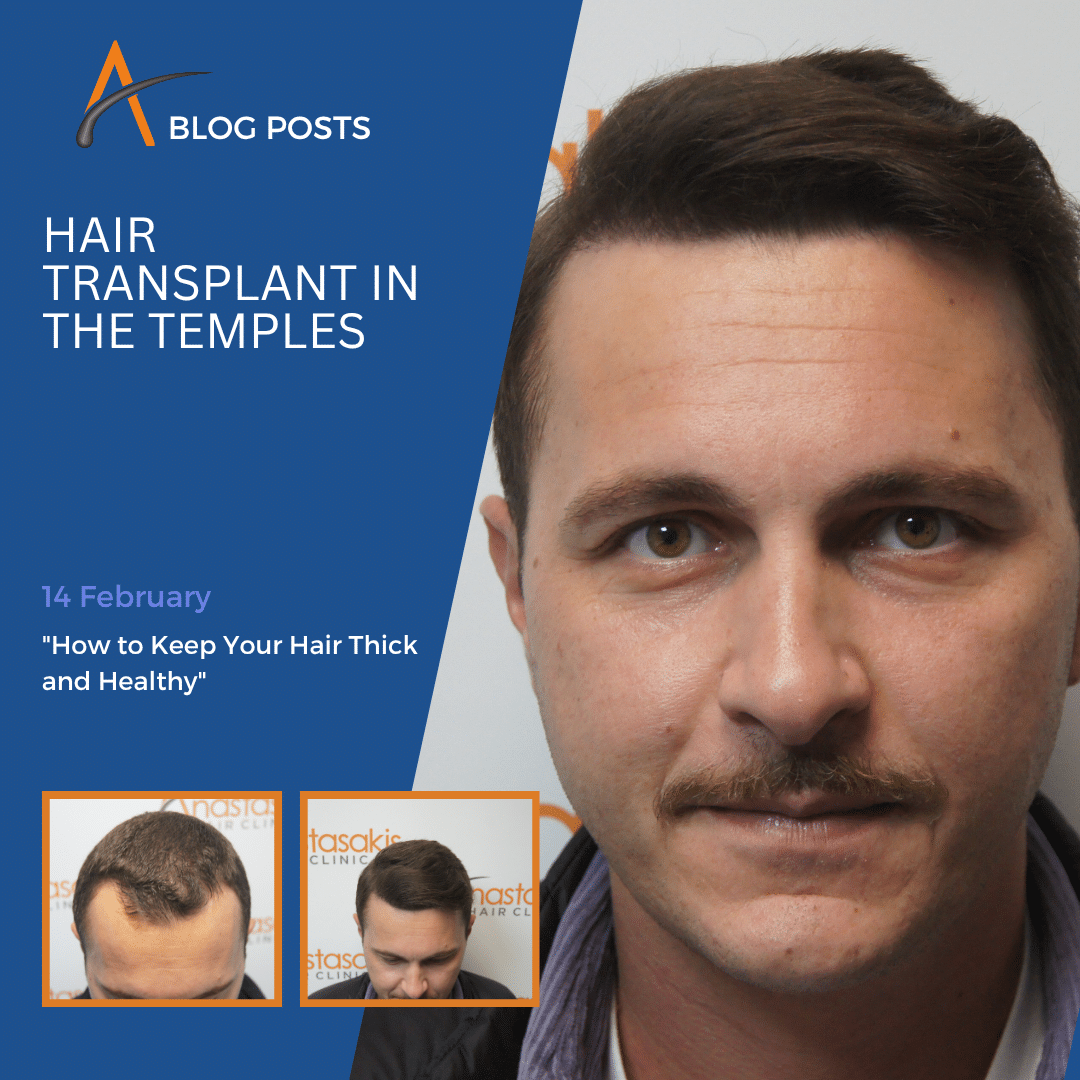How to Distinguish a Natural from an Unnatural Hair Transplant?The answer is simple and starts with the hairline. In hair transplantation, the front hairline plays a crucial role in achieving a natural and dense aesthetic result. It acts as the “frame” of the face, defining the balance and harmony of facial features.
A natural hairline transplant can boost confidence, while an unnatural hairline is often easily detectable, detracting from the overall appearance.
In this article, we will explore what makes a hair transplant look natural, the signs that indicate an unsuccessful procedure, and tips on choosing the right surgeon.
What Makes a Hair Transplant Look Natural?
The success of a hair transplant depends on many factors, with the surgeon’s skill to create a truly natural result being the most important. A detailed analysis of the patient’s hair characteristics—both quantitative and qualitative—along with careful planning of the procedure, are critical steps in achieving the ideal aesthetic outcome. An experienced surgeon considers the natural hairline, hair texture, density, and future needs, ensuring the result looks natural and long-lasting, while restoring confidence and satisfaction.
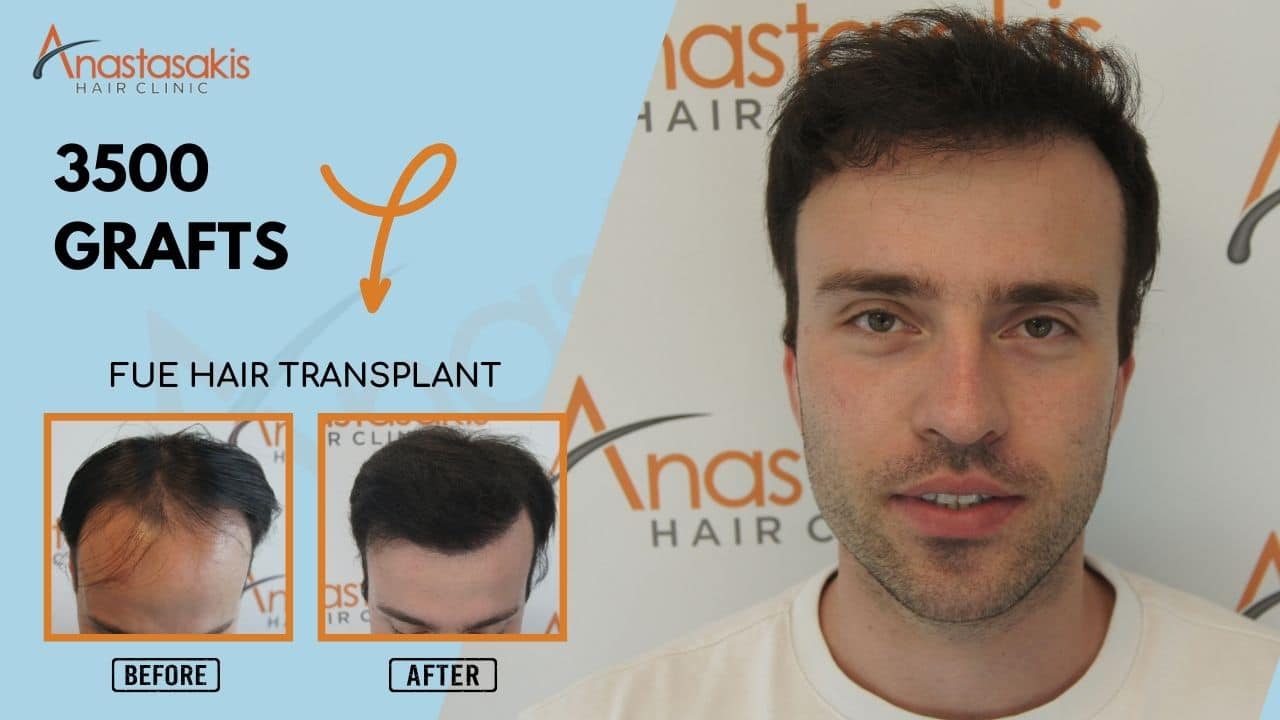
Proper Placement of Follicular Units in the Hairline
One of the most important factors for achieving a natural-looking hair transplant at the hairline is the correct placement of the follicular units. Naturally, hair at the hairline does not grow in straight lines or perfect symmetry. Instead, it has an irregular distribution that gives it a natural appearance. A skilled hair transplant surgeon must place the follicular units in a way that mimics this irregular growth pattern.
More specifically, the direction and angle at which the follicular units are implanted in the hairline are of utmost importance. The natural hair growth angle varies depending on the area of the scalp.
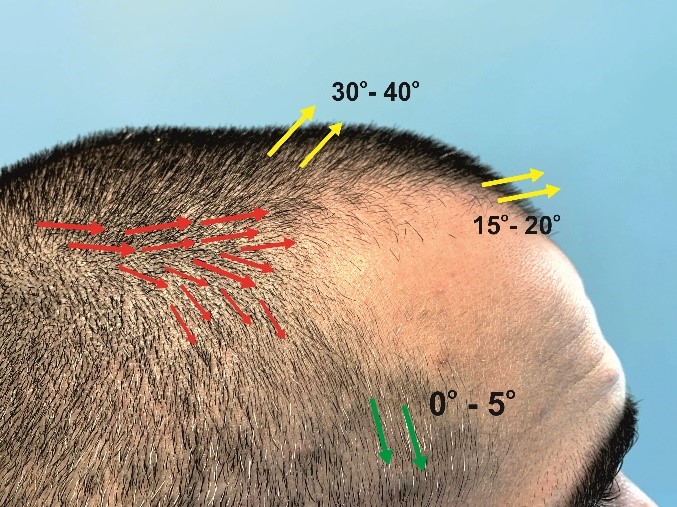
As shown in the image above, the follicular units at the hairline always grow forward and emerge at a sharp angle of just 10°-15°. This acute angle provides the correct and natural coverage, unlike grafts implanted vertically, which unfortunately some “specialists” still perform.
The angle of the recipient sites must follow the natural direction of any remaining hairs in the area. An experienced hair transplant surgeon knows how to recreate these subtle natural variations in direction and density so that the transplant blends seamlessly with the native hair and maintains a fully natural appearance.
Single-hair follicular units are positioned along the very front edge of the hairline, while as we move further back, the hairs become thicker and grafts may contain multiple hairs. This natural pattern is always respected in the design by an expert surgeon.
Proper Density
The density of the hairline is another crucial factor contributing to a natural-looking result. Too low a density can make the transplant appear obviously unnatural.
Depending on the surgeon’s skill, exclusively single-hair follicular units (FUs) can be used in both zones with very high density (dense packing). The density at which the hairline is transplanted depends on the hair characteristics and the experience of the surgical team.
The dense packing technique has faced criticism from many surgeons, as in some patients, such a dense placement of grafts paradoxically results in reduced growth.
Therefore, the appropriate ratio and density should be achieved based on the patient’s natural hair distribution, age, and overall health. A skilled surgeon will ensure that the outcome looks natural and is proportionate to the symmetry of the patient’s face.
How to Recognize the Signs of an Unnatural Hairline Hair Transplant
Unfortunately, not all hair transplants are successful, and an unnatural result can cause significant aesthetic and psychological issues. There are several clear signs that indicate the hairline or the overall outcome of the transplant does not look natural.
“Unnatural Hairline”
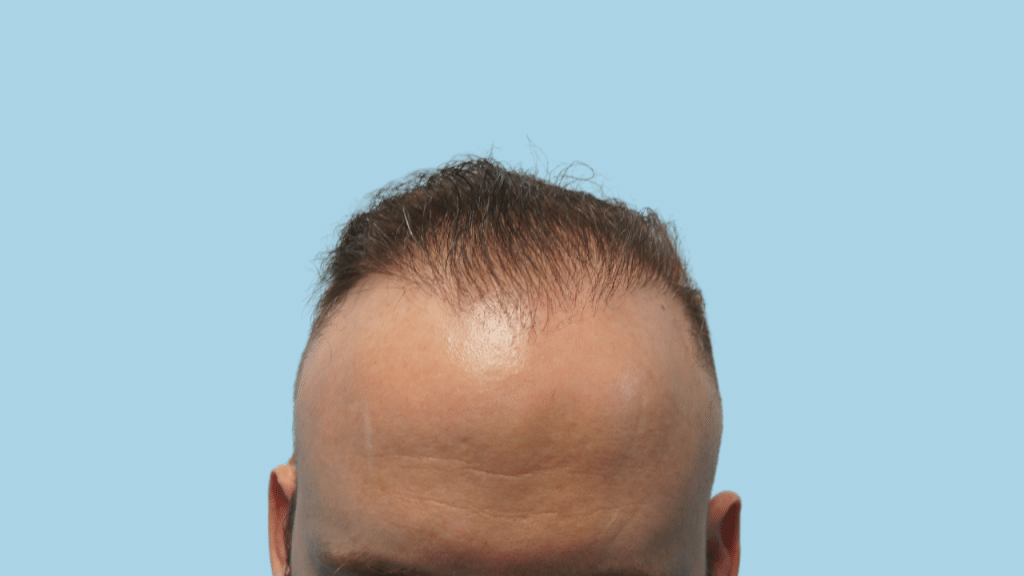
The Most Common Sign of an Unnatural Hair Transplant: The Hairline
The most common indicator of an unnatural hair transplant is an artificial-looking frontal hairline. A hairline that appears overly straight, uniform, or symmetrical—contrasting with the natural curvature of the forehead—can look fake. A natural hairline exhibits subtle irregularities, with hairs that are typically finer and sparser in this area. Failing to recreate these delicate details often results in a “fake” appearance.
“Incorrect Hair Growth Direction”
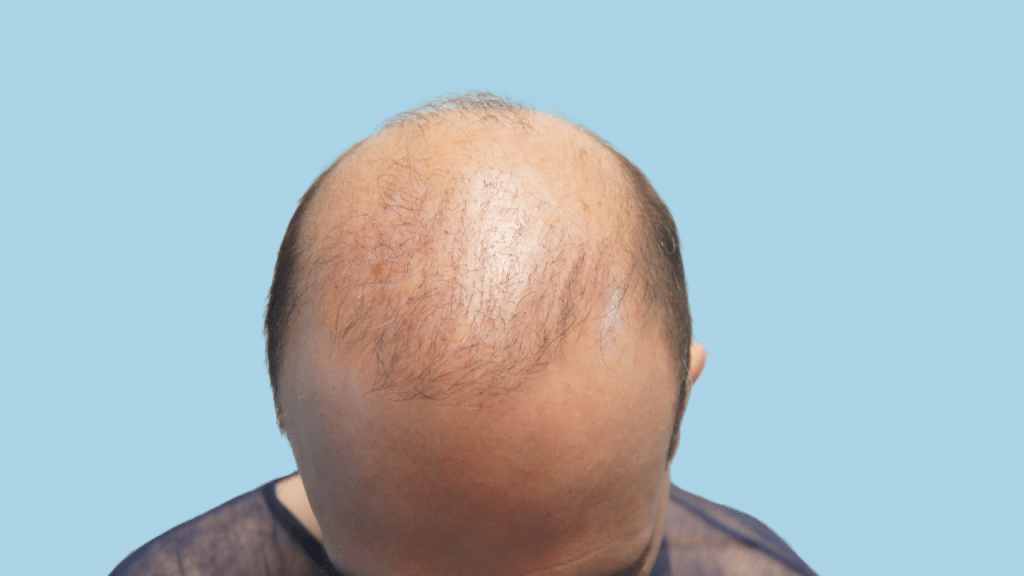
Result of a Hair Transplant Performed by Another Clinic
If you take a closer look at the hairline, you’ll notice that some hairs are growing sideways while others point forward.
One of the most common signs of a poorly executed hair transplant is incorrect hair direction. When hair grows at unnatural angles or in multiple directions that don’t align with the natural growth pattern, the result looks noticeably artificial. Precise placement of each follicular unit at the correct angle and direction is essential in order to achieve a natural-looking outcom
“Lack of Density Uniformity”
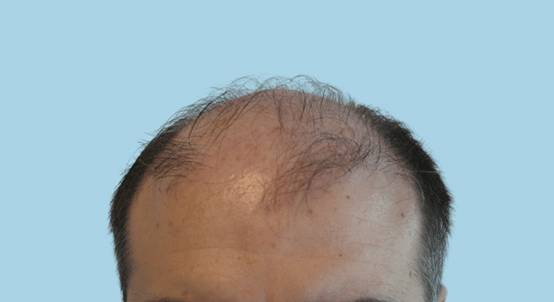
Lack of Density Uniformity
An unnaturally dense or overly sparse distribution of hairs can easily reveal an artificial-looking hair transplant—especially along the hairline. In a natural hairline, density is not perfectly uniform; instead, it features subtle variations that contribute to a more organic appearance.If too many hairs are placed too close together, the result may appear overly compact or “pluggy.” On the other hand, placing too few grafts can lead to a thin, patchy, and unnatural look.
How to Choose the Right Hair Transplant Surgeon for a Natural-Looking Hairline
Selecting the right surgeon is one of the most critical factors in achieving a successful hair transplant—especially when it comes to restoring the hairline. A skilled and experienced specialist is essential to ensure a natural-looking result.
It’s also important to consider which technique is best suited to your individual needs. Will you benefit more from an FUE (Follicular Unit Extraction) or a FUT (Follicular Unit Transplantation) procedure?
Below are some key guidelines to help you choose the right professional and the most suitable method for your case.
Look for: Credentials, Experience, and Specialization
A licensed medical doctor who specializes in hair restoration and has extensive experience is far more likely to deliver excellent, natural-looking results.
Make sure your surgeon holds the proper medical degree and certifications, and has performed a significant number of procedures with consistent outcomes. Ask to see before-and-after photos, and more importantly, video testimonials and results from previous patients—ideally with hair types and facial features similar to yours.
This is the most reliable way to evaluate the surgeon’s work and get a realistic idea of what to expect.

The Importance of a Proper Consultation Session
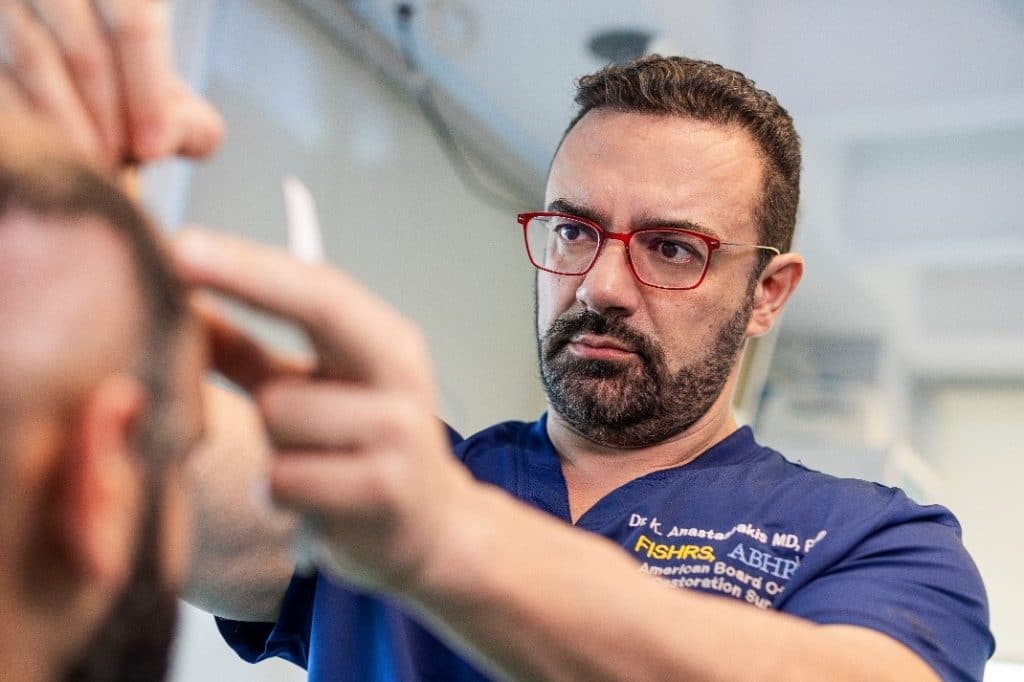
During the consultation, your doctor should carefully examine your scalp, assess your hair density and natural hairline, take the necessary measurements, and walk you through the entire procedure. A detailed hairline design should be created specifically for you—visually showing how your new hairline will look.
Make sure the surgeon is genuinely willing to guide you through the decision-making process to help you achieve a natural and, above all, timeless hairline that complements your unique facial features and age.Each patient is different, and hairline design should never be a one-size-fits-all solution. Unfortunately, some so-called “clinics” are known for their identical, triangle-shaped hairlines—applied indiscriminately to every patient. The results are often unnatural, harsh, and aesthetically unappealing, leaving individuals dissatisfied and with long-term regrets.
Considering Hairline Restoration? Here’s What You Need to Know
If you’re thinking about restoring your hairline and want results that look truly natural, remember this:
A hair transplant is an investment in your confidence and overall appearance. That’s why the outcome should not only look natural—but ideally, it should go completely unnoticed.
Achieving a natural-looking hairline relies heavily on the surgeon’s expertise, aesthetic eye, and precise execution—especially when it comes to designing and placing grafts in harmony with your unique facial features.
Before choosing who to trust with your procedure, do your research. Talk openly about your expectations and make sure the doctor has the experience and technical skills required to deliver an excellent, discreet, and natural-looking result.Most importantly, ask to see multiple examples of previous patients with cases similar to yours—not just before-and-after photos, but videos that clearly show the outcome from different angles and in different lighting.
If you’re looking for a truly natural and guaranteed result, contact us to book your consultation—either in person at our clinic or online—and find out if you’re a suitable candidate for a hair transplant.










